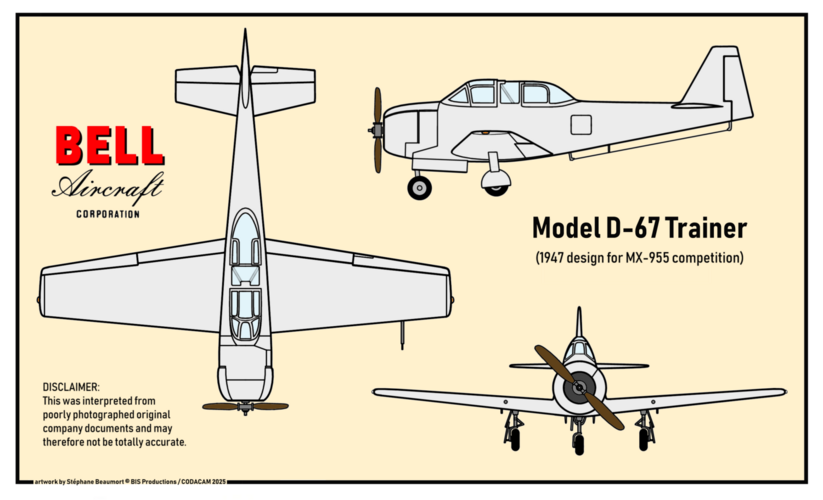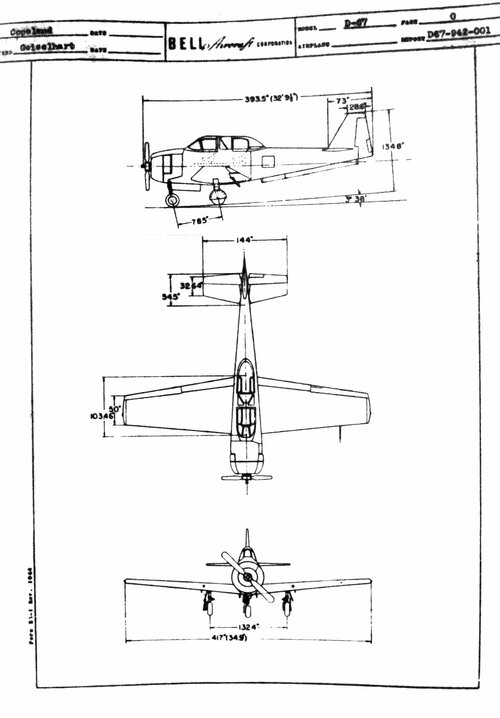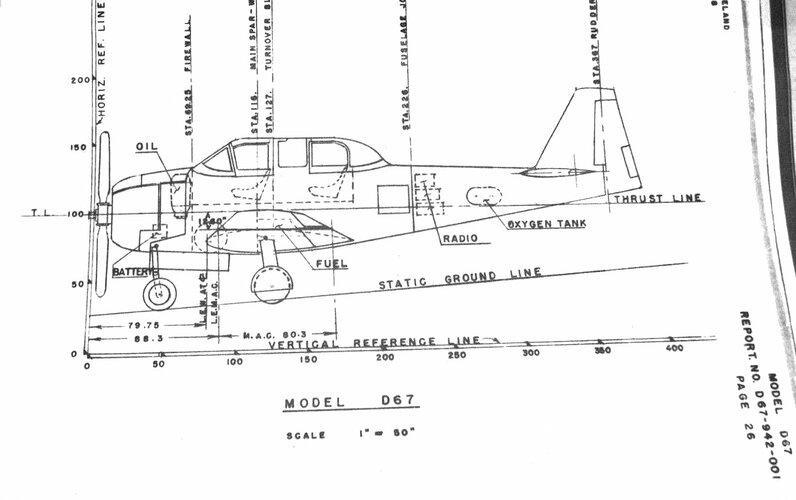DOUGLAS XT-30
This design proposal (previously illustrated in Flight of December 30th, 1948) was the runner-up to the T-28 in the aforementioned design competition held last year. Although the design study did not materialize even as far as a prototype aircraft, it was considered promising enough to warrant further evaluation, and Douglas were given a half-million-dollar contract to build an experimental mock-up. Perhaps, however, the term " mock-up " does the construction seen in the accompanying illustration less than justice, since in reality it amounted to a fairly complete operational power-plant test-bed to work the bugs out of the submerged engine, with remote airscrew drive, which was the backbone feature of the design.
The basic design concept of the XT-30 was a two-seater revival of the Bell P-39 Airacobra formula, wherein the engine is completely buried at mid-fuselage immediately aft of the rear cockpit and over the rear portion of the wing root, the tractor airscrew being driven by an extension shaft under the cockpit floor. An obvious advantage of such a scheme is that, since the engine weight is shifted aft, both tandem seats can be located forward of the wing, thereby giving the occupants an unobstructed forward and downward view over the sharply tapered nose—the kind of view, in fact, that one properly associates with the jet fighter.
Compared with the orthodox approach exemplified in the T-28, there can be no gainsaying that the XT-30 layout lends itself to a much better (and, therefore, safer) view for both student and instructor ; also that the aerodynamic configuration of the fuselage is markedly superior because of the finer nose-entry and the higher propulsive efficiency of the body-airscrew combination. Another good feature that logically follows from the rear-engine installation is the longer wheelbase of the nose-wheel tricycle landing gear—again the sort of thing that ties in with jet-fighter landing technique and ground-stability characteristics.
From the maintenance standpoint, Douglas engineers claimed that the midship power plant lent itself to improved accessibility of engine and accessories, but on the face of it this seems a bit harder to justify. Admittedly, a six-man maintenance crew had been timed to remove and install an engine in slightly over 20 minutes; however, we suspect that a six-man engine crew for a two-seater trainer would be looked at askance by commercial school-operators. A possible answer might be found in designing the rear half of the fuselage with detachable joints aft of the engine bay, following jet-fighter construction again.
Judging from the view of the mock-up, the XT-30 would have been a clean, square-cut, straightforward low-wing job with a span of 36ft 4in, length of 36ft 10in and overall height of 13ft 7in. The submerged engine was an 800 h.p. Wright R-1300 radial, similar to that installed in the T-28, hence the maximum fuselage-width must have been at least 4ft 6in in the region of the rear cockpit. Cooling, we believe, was arranged through an air scoop on the underside of the nose cowling. Incidentally, looking at the long fuselage nose and bubble canopy forward of the e.g., one cannot help feeling that the vertical tail geometry is shy on dorsal finning.
Estimated performance was a top speed of 286 m.p.h. at ro,oooft, a cruise speed of 190 m.p.h. for 61/4 hours, and a service ceiling of 29,600ft. A picturesque gross weight of 5,999 lb was also quoted, a figure which may be taken as an impressive token of the weight guestimator's art, seeing that the power plant alone (not to mention the rest of the equipment supplied from outside sources) could vary as much as plus or minus 10 lb. Furthermore, since the T-28 is now quoted at 6,759 lb, it is tolerably certain that the XT-30, with its remote airscrew drive, would have scaled something over the 7,000 lb mark—which, no doubt, is impressive hindsight on our part!
Because the airframe designer must perforce make the best of existing power plants within the desired power range, it is no reflection on either the T-28 winner or the XT-30 runner-upto say that they both suffer from the handicap of trying to mate an overgrown seven-cylinder radial engine of 50m diameter with a two-seater tandem cockpit layout, resulting in a body width at least 50 per cent greater than is really necessary or desirable for aerodynamic and vision requirements. Perhaps this sort of excess elbow-room may be more pardonable at the high-powered advanced stage of training, but it strikes us as a bit awe-inspiring for the raw recruit. Indeed, it rather reminds us of the first time we were persuaded to straddle a horse —we were amazed at the enormous expanse of the beast in plan view!
Doubtless it is better to have the chrysanthemum behind, rather than in front of one's face, but nevertheless the submerged-rear-engine scheme is a belated attempt to make the best of the existing engine situation at the expense of engineering complexity, weight and cost. A dozen or so years ago the Bell fighter layout appealed to us very strongly as an outstanding design concept but, to-day, in view of the rapid advance of the turbine art, the logical answer for the pre-jet trainer is obviously the small-diameter turboprop engine on the lines of the A.S. Mamba or the R.R. Dart. We suggest, though, that the power required might be trimmed back to 500 or 600 s.h.p. for a tandem two-seater layout.
































